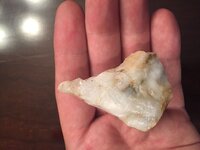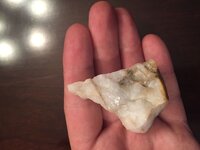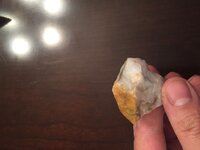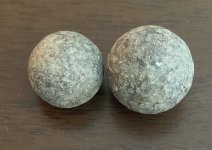Upvote
0
You are using an out of date browser. It may not display this or other websites correctly.
You should upgrade or use an alternative browser.
You should upgrade or use an alternative browser.
Quartz drill?
- Thread starter Wes213
- Start date
autographcollector11
Sr. Member
- Sep 18, 2011
- 338
- 175
I think u guessed right....looks natural.
cool shape tho.
cool shape tho.
- Thread starter
- #3
I think u guessed right....looks natural.
cool shape tho.
I am not sure if I understand your statement?
willjo
Bronze Member
- Apr 30, 2015
- 1,069
- 2,014
- Detector(s) used
- Garrett GTA 350 and Garrett ace 150
- Primary Interest:
- All Treasure Hunting
I am not sure if I understand your statement?
He is saying it is a rock not used as a drill.
- Thread starter
- #5
He is saying it is a rock not used as a drill.
How does Quartz naturally form this shape? Keep in mind this was recovered from a site.
Mrdigz
Hero Member
- Nov 14, 2015
- 665
- 355
- Detector(s) used
- 2 Whites MXT pros. Bullseye 2 & Bullseye trx pinpointers.
- Primary Interest:
- All Treasure Hunting
Don't think it was used as anything. Quartz rocks can form in lots of shapes.
Maybe it was brought there and was going to be made into something later on down the line. But that's just assumption. HH
Maybe it was brought there and was going to be made into something later on down the line. But that's just assumption. HH
Charl
Silver Member
How does Quartz naturally form this shape? Keep in mind this was recovered from a site.
It could very well represent, and likely is, a piece of quartz fractured by humans while engaged in tool making. You could think of it as a large flake in that respect. But not itself an actual tool. Without visible cortex, had it been a quartz cobble, and by its appearance and where you found it, it likely is not natural. But neither is it an artifact, in all likelihood.
Charl
Silver Member
In other words, come across a quartz workshop, and you might find pieces of fractured quartz like that. Cannot prove it did not fracture that way naturally, but it would be a bit unusual for it not to show natural weathering, and a softening of the sharp lines over time, had that been the case. In this case, it resembles chunks fractured and discarded at a workshop. Since you found it at a known camp, that's probably what it represents. But, just my best guess, having come cross the situation at camps on numerous occasions.
In other words, come across a quartz workshop, and you might find pieces of fractured quartz like that. Cannot prove it did not fracture that way naturally, but it would be a bit unusual for it not to show natural weathering, and a softening of the sharp lines over time, had that been the case. In this case, it resembles chunks fractured and discarded at a workshop. Since you found it at a known camp, that's probably what it represents. But, just my best guess, having come cross the situation at camps on numerous occasions.
I know when we discuss quartz/quartzite, there are differences of opinions. Man may or may not have fractured it to that shape. However NAs did use whatever stone was available in the area they were living if they were living any distance away from a "good stone" quarry area (in NC that mostly meant living any distance from the rhyolite around the Uwharrie mtns). Randy Daniel in his book Hardaway Revisited concluded that when living any distance form the Uwharries, NAs conserved the good stone (rhyolite) for points, tools, etc and tried to make do with other stone when possible. And at Cactus Hill, more than 85% of the debitage was the fracture and shatter debris of quartz and quartzite. Hope I haven't opened a can of worms here.
- Thread starter
- #10
In other words, come across a quartz workshop, and you might find pieces of fractured quartz like that. Cannot prove it did not fracture that way naturally, but it would be a bit unusual for it not to show natural weathering, and a softening of the sharp lines over time, had that been the case. In this case, it resembles chunks fractured and discarded at a workshop. Since you found it at a known camp, that's probably what it represents. But, just my best guess, having come cross the situation at camps on numerous occasions.
Thank you for the thoughtful response. I really appreciate the fact that you took the time to teach and explain why, rather then just saying " Quartz forms that way naturally " or "that's just a rock". The site I am on is most likely a work shop, the NA's here seemed obsessed with Quartz cobbles, I find them split and abraded very often. I would say that yea it is very likely this piece was just a byproduct of something else, but to say that that it is just a rock shows poor judgment. Seriously to say that Quartz forms naturally like this is an uneducated response.
Last edited:
Charl
Silver Member
I know when we discuss quartz/quartzite, there are differences of opinions. Man may or may not have fractured it to that shape. However NAs did use whatever stone was available in the area they were living if they were living any distance away from a "good stone" quarry area (in NC that mostly meant living any distance from the rhyolite around the Uwharrie mtns). Randy Daniel in his book Hardaway Revisited concluded that when living any distance form the Uwharries, NAs conserved the good stone (rhyolite) for points, tools, etc and tried to make do with other stone when possible. And at Cactus Hill, more than 85% of the debitage was the fracture and shatter debris of quartz and quartzite. Hope I haven't opened a can of worms here.
interesting observations. It may be relevant to learn, that beginning in the Late Archaic, throughout eastern North America, a so-called pebble technology developed. The stemmed variety of Lamoka points are often regarded as where it started. A whole series of points similar to Lamokas, and predominently made of quartz in New England, for instance, as well as tools like scrapers, knives, and perforators, began to be fashioned directly from suitable sized quartz pebbles. Pebbles could be found anywhere, especially quartz, and could also be carried in a tool quick, for quick conversion into those several tool forms.
This led to a reduction in reliance on quarries for procuring tool stone, and this led to greater mobility in both temporal and special terms. No matter where one was in the seasonal round, or what time of year, one could easily find pebbles. So, it is now becoming clear that this pebble technology, this pebble tool industry was behind the production of many of our so-called "small stem points" here in eastern North America.
Here is a Squibnocket Stemmed point I found a couple of days ago. It was fashioned from a pebble, not from quarried stone. The development of this quartz pebble industry was a key development resulting in many of the smaller points and tools found in our assemblages. For instance, in Maine, there are no known Brewerton sites, but Brewerton points are found, only in association with small stem points. It is believed, that as various knife forms and point forms evolved in various native cultures, such as the Brewerton series of points, that these evolving forms were simply adopted into this present and long enduring pebble tool kit. Points made from quartz pebbles continued to dominate right into Late Woodland times, here in southern New England.
Several point styles in the East, including Lamoka, Wading River, Squibnocket, Swan Lake, and Bradley Spike all often show the original pebble rind on an un worked base, demonstrating that all these points were the result of a pebble industry and technology, not from quarries.
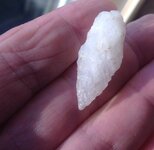
Charl
Silver Member
View attachment 1364442
One of the dominant lithic tool stones found in southern New England is argillite, of the argillaceous slate variety. (NJ and Pa argillite is of the argillaceous shale variety). It was quarried in two main locations, one in Ma and one in RI. But that does not mean that the only argillite procured came from those known outcrops. Here is an example of an argillite end pick(a soapstone industry tool) found in a field that yields 95% small stem points made from quartz pebbles. The same field that yielded the quartz point shown in my previous comment. It shows cobble cortex on both sides. It was not quarried. It was made from a cobble or large pebble if you would. And one would expect, that once a pebble technology or tool making industry had come to dominate over stone procured from quarries, that natives would be very ambitious in collecting tool stone that way, as pebbles and cobbles. Our landscape is littered with glacial pebbles and cobbles that represent the same types of tool stone present at quarry sites. But, if they are present on a site, a lot easier to pick 'em up off the ground and use them, then to travel to a distant quarry site and obtain the tool stone there.
View attachment 1364441
View attachment 1364441
Top Member Reactions
-
 2588
2588 -
 1138
1138 -
 1063
1063 -
 901
901 -
 882
882 -
 848
848 -
 805
805 -
 695
695 -
 633
633 -
 551
551 -
 489
489 -
 478
478 -
 477
477 -
 464
464 -
 462
462 -
O
433
-
 428
428 -
 391
391 -
 380
380 -
 361
361
Users who are viewing this thread
Total: 2 (members: 0, guests: 2)
